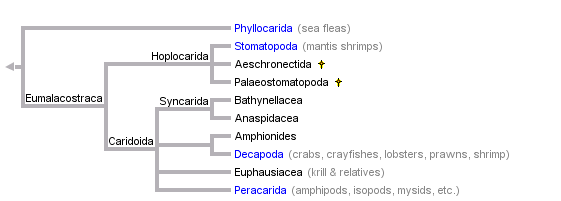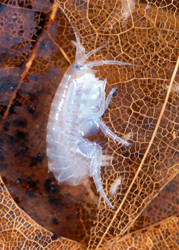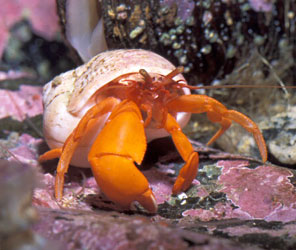Malacostraca



This tree diagram shows the relationships between several groups of organisms.
The root of the current tree connects the organisms featured in this tree to their containing group and the rest of the Tree of Life. The basal branching point in the tree represents the ancestor of the other groups in the tree. This ancestor diversified over time into several descendent subgroups, which are represented as internal nodes and terminal taxa to the right.

You can click on the root to travel down the Tree of Life all the way to the root of all Life, and you can click on the names of descendent subgroups to travel up the Tree of Life all the way to individual species.
For more information on ToL tree formatting, please see Interpreting the Tree or Classification. To learn more about phylogenetic trees, please visit our Phylogenetic Biology pages.
close boxReferences
Jarman, S. N., S. Nicol, N. G. Elliott, and A. McMinn. 2000. 28S rDNA evolution in the Eumalacostraca and the phylogenetic position of krill. Molecular Phylogenetics and Evolution 17:26–36.
Martin, J. W. and G. E. Davis. 2001. An updated Classification of the Recent Crustacea. Natural History Museum of Los Angeles County Science Series 39. Los Angeles, CA.
Mauchline, J. 1984. Euphausiid, Stomatopod and Leptostracan Crustaceans: Keys and Notes for the Identification of the Species. Synopses of the British Fauna, New Series, no. 30. Estuarine and Brackish-water Sciences Association. Linnean Society of London. E.J Brill / Dr W. Backhuys, Leiden.
Richter, S. and G. Scholtz. 2001. Phylogenetic analysis of the Malacostraca (Crustacea). Journal of Zoological Systematics and Evolutionary Research 39:113-136.
Scholtz, G. 2000. Evolution of the nauplius stage in malacostracan crustaceans. Journal of Zoological Systematics and Evolutionary Research 38:175-187.
Schram, R. F. 1977. Paleozoogeography of Late Paleozoic and Triassic Malacostraca. Systematic Zoology 26:367-379.
Schram, F. and C. H. J. Hof. 1998. Fossils and the interrelationships of major crustacean groups. Pages 233-302 in Arthropod Fossils and Phylogeny. G. D. Edgecombe, ed. Columbia University Press, New York.
Spears, T. and L. G. Abele. 1998. Crustacean phylogeny inferred from 18S rDNA. Pages 169-187 in Arthropod Relationships. R. A. Fortey and R. H. Thomas, eds. Systematics Association Special Volume Series 55. Chapman & Hall, London.
Spears, T. and L. G. Abele. 1999. The phylogenetic relationships of crustaceans with foliaceous limbs: an 18S rDNA study of Branchiopoda, Cephalocarida, and Phyllocarida. Journal of Crustacean Biology 19:825-843.
Watling, L. 1983. Peracaridan disunity and its bearing on eumalacostracan phylogeny with a redefinition of eumalacostracan superorders. Pages 213-228 in Crustacean Phylogeny, Crustacean Issues, Vol. 1. F. R. Schram, ed., A. A. Balkema, Rotterdam.
Watling, L., C. H. J. Hof, and F. R. Schram. 2000. The place of the Hoplocarida in the Malacostracan pantheon. Journal of Crustacean Biology 20(Special Issue):1-11.
Wills, M.A. 1998. A phylogeny of Recent and fossil Crustacea derived from morphological characters. Pages 189-209 in Arthropod Relationships. R. A. Fortey and R. H. Thomas, eds. Systematics Association Special Volume Series 55. Chapman & Hall, London.
Title Illustrations

| Scientific Name | Hyalella azteca |
|---|---|
| Creator | Scott Bauer |
| Source | Image Number K8451-1 |
| Source Collection | Agricultural Research Service Image Gallery |
| Scientific Name | Elassochirus gilli |
|---|---|
| Location | NOAA Auke Bay Lab, Juneau, Alaska, USA |
| Specimen Condition | Live Specimen |
| Source | Elassochirus gilli; Pacific Red Hermit Crab |
| Source Collection | CalPhotos |
| Copyright | © 2001 |
| Scientific Name | Stomatopoda |
|---|---|
| Location | Lembeh Straits, North Sulawesi, Indonesia |
| Specimen Condition | Live Specimen |
| Source | Mantis shrimp |
| Source Collection | Flickr |
| Image Use |
 This media file is licensed under the Creative Commons Attribution-NonCommercial-NoDerivs License - Version 2.0. This media file is licensed under the Creative Commons Attribution-NonCommercial-NoDerivs License - Version 2.0.
|
| Copyright | © 2007 scian |
About This Page
Page copyright © 2002
All Rights Reserved.
Citing this page:
Tree of Life Web Project. 2002. Malacostraca. Version 01 January 2002 (temporary). http://tolweb.org/Malacostraca/6253/2002.01.01 in The Tree of Life Web Project, http://tolweb.org/











 Go to quick links
Go to quick search
Go to navigation for this section of the ToL site
Go to detailed links for the ToL site
Go to quick links
Go to quick search
Go to navigation for this section of the ToL site
Go to detailed links for the ToL site